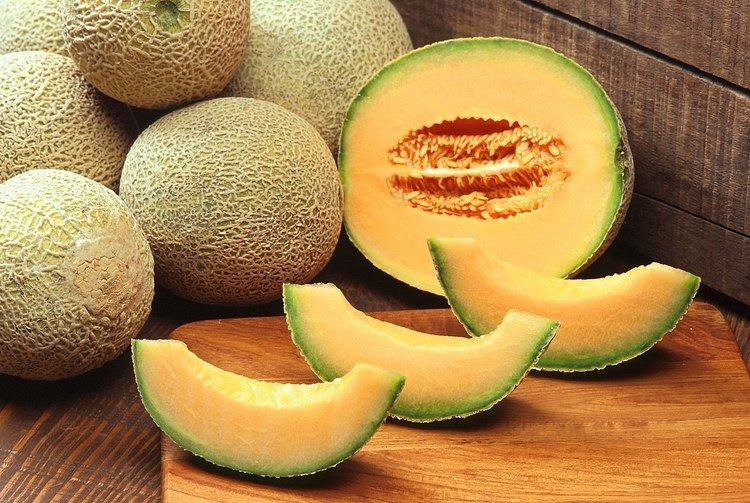Kingdom Plantae Family Cucurbitaceae Species C. melo | Order Cucurbitales Genus Cucumis Subspecies C. melo subsp. melo | |
 | ||
Cantaloupe (also cantelope, cantaloup, muskmelon (India and the United States), mushmelon, rockmelon, sweet melon, Persian melon, or spanspek (South Africa)) refers to a variety of the Cucumis melo species in the Cucurbitaceae family.
Contents
Cantaloupes range in weight from 0.5 to 5 kilograms (1 to 11 lb). Originally, cantaloupe referred only to the non-netted, orange-fleshed melons of Europe. However, in more recent usage it has come to mean any orange-fleshed melon of C. melo, and has become the most popular melon in North America.
Etymology and origin
The name is derived via French cantaloup from Italian Cantalupo, which was formerly a papal county seat near Rome, after the fruit's introduction there from Armenia. It was first mentioned in English literature in 1739.
The cantaloupe most likely originated in a region from Iran to India and Africa. It was later introduced to Europe and, around 1890, became a commercial crop in the United States.
European vs. North American
The European cantaloupe is lightly ribbed with a sweet and flavorful flesh and a gray-green skin that looks quite different from that of the North American cantaloupe.
The North American cantaloupe, common in the United States, Mexico, and some parts of Canada, is actually a muskmelon, a different variety of Cucumis melo, and has a "net-like" (reticulated) skin covering. It is a round melon with firm, orange, moderately sweet flesh and a thin, reticulated, light-grey rind. Varieties with redder and yellower flesh exist, but are not common in the US commercially.
Production
In 2013, the world production of melons, including cantaloupes, was 29.4 million tonnes, with China accounting for 49% of the total (14.4 million tonnes). Other significant countries growing cantaloupe in 2013 were Turkey, Iran, Egypt and India, which each grew 1 to 1.7 million tonnes.
Because they are descended from tropical plants and tend to require warm temperatures throughout a relatively long growing period, cantaloupes grown in temperate climates are frequently started indoors for 14 days or longer before being transplanted outdoors.
Cantaloupes are often picked, and shipped, before fully ripening. One post-harvest practice is treatment with a sodium hypochlorite or bleach wash to prevent mold and Salmonella growth. This treatment, because it can mask the melon's musky aroma, can make it difficult for the purchaser to judge the relative quality of different cantaloupes.
Consumption
Cantaloupe is normally eaten as a fresh fruit, as a salad, or as a dessert with ice cream or custard. Melon pieces wrapped in prosciutto are a familiar antipasto.
Because the surface of a cantaloupe can contain harmful bacteria—in particular, Salmonella—it is recommended to wash and scrub a melon thoroughly before cutting and consumption. The fruit should be refrigerated after cutting it and consumed in less than three days to prevent risk of Salmonella or other bacterial pathogens.
A moldy cantaloupe in a Peoria, Illinois market in 1943 was found to contain the highest yielding strain of mold for penicillin production, after a worldwide search.
Nutrition
Raw cantaloupe is 90% water, 8% carbohydrates, 0.8% protein and 0.3% fat, providing 140 kJ (34 kcal) and 2020 μg of the provitamin A orange carotenoid, beta-carotene per 100 grams. Fresh cantaloupe is an excellent source (20% or more of the Daily Value or DV) of vitamin C (44% DV) and vitamin A (21% DV), with other nutrients in negligible amounts (less than 10% DV) (see table).
